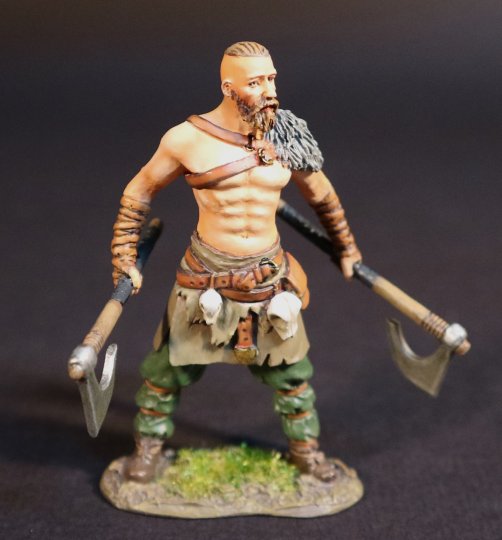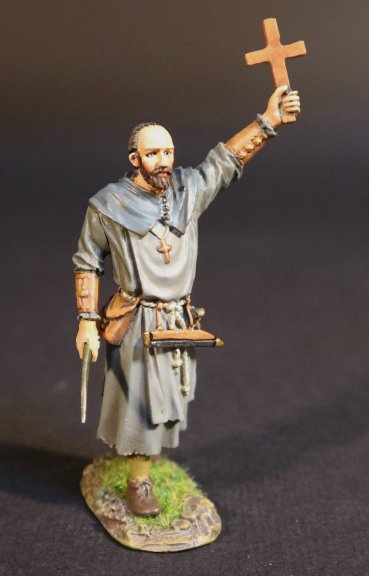- Joined
- Feb 2, 2011
- Messages
- 2,093
NEW RELEASES FOR DECEMBER 2024
THE AGE OF ARTHUR
THE VIKINGS
VIKING BERSERKERS
In the Viking world, berserkers were those who were said to have fought in a trance like fury, a characteristic which later gave rise to the modern English word “berserk”, meaning “furiously violent or out of control”.
In battle, the berserkers were subject to fits of frenzy. They would howl like wild beasts, foamed at the mouth, and gnawed the iron rim of their shields. According to belief, during these fits they were immune to steel and fire, and made great havoc in the ranks of the enemy. When the fever abated they were weak and tame. Accounts can be found in the sagas.
When Viking villages went to war in unison, the berserkers often wore special clothing, for instance furs of a wolf or bear, to indicate that this person was a berserker, and would not be able to tell friend from foe when in "bersærkergang". In this way, other allies would know to keep their distance.
The old Norse form of the word was “berserkr”, which likely means “bear-shirt”, or as a thirteen century historian interpreted as “bare shirt”, which could refer to those warriors who went into battle without armour.
Other historians reinforce their theory of the “bear shirt” by the fact that it is believed berserkers drew their power from the bear and were devoted to a bear cult, which was once widespread across the northern hemisphere.
The bear-warrior symbolism survives to this day in the form of the bearskin caps worn by the guards of the Danish monarchs.
Wolf warriors appear among the legends of many countries. The Germanic wolf warriors have left their trace through shields and standards that were captured by the Romans and displayed in Rome.
The warriors wearing the skins of wolves were actually called “Ulfheonar” (wolf coat), which was another term associated with berserkers.
These warriors were said to wear the pelt of a wolf when they entered battle, and are sometimes described as Odin’s special warriors.

VIK-08
THE AGE OF ARTHUR,
THE VIKINGS,
VIKING BERSERKER
THE ANGLO SAXON/DANES
During battles in Anglo Saxon England, priests played significant roles within the context of warfare as well as in society in general. Priests were spiritual leaders who provided guidance, blessings and prayers to warriors before a battle. They offered solace and encouraged courage, emphasizing the divine purpose of the conflict. They would bless weapons, armour and soldiers, invoking divine protection and favour.
Before battles warriors could confess their sins to priests seeking forgiveness and spiritual readiness.
Priests would accompany armies to the battlefield where they could tend to wounded soldiers and perform last rites to the fallen. Priests could perform basic medical support, and offer prayers for healing.
They ensured proper burial for the dead, emphasizing the importance of a Christian burial even amidst the chaos of war.
They could carry sacred relics, crosses and banners into battle, symbolizing divine protection and inspiring morale.
Therefore Anglo Saxon priests were not merely bystanders during battles, they actively participated bridging the spiritual and earthly realms, providing comfort, guidance and hope to warriors in the midst of battle.

SX-70
THE AGE OF ARTHUR,
THE ANGLO SAXON/DANES,
ANGLO SAXON PRIEST
** PLEASE CONTACT YOUR LOCAL DEALER FOR FURTHER INFORMATION **
THE AGE OF ARTHUR
THE VIKINGS
VIKING BERSERKERS
In the Viking world, berserkers were those who were said to have fought in a trance like fury, a characteristic which later gave rise to the modern English word “berserk”, meaning “furiously violent or out of control”.
In battle, the berserkers were subject to fits of frenzy. They would howl like wild beasts, foamed at the mouth, and gnawed the iron rim of their shields. According to belief, during these fits they were immune to steel and fire, and made great havoc in the ranks of the enemy. When the fever abated they were weak and tame. Accounts can be found in the sagas.
When Viking villages went to war in unison, the berserkers often wore special clothing, for instance furs of a wolf or bear, to indicate that this person was a berserker, and would not be able to tell friend from foe when in "bersærkergang". In this way, other allies would know to keep their distance.
The old Norse form of the word was “berserkr”, which likely means “bear-shirt”, or as a thirteen century historian interpreted as “bare shirt”, which could refer to those warriors who went into battle without armour.
Other historians reinforce their theory of the “bear shirt” by the fact that it is believed berserkers drew their power from the bear and were devoted to a bear cult, which was once widespread across the northern hemisphere.
The bear-warrior symbolism survives to this day in the form of the bearskin caps worn by the guards of the Danish monarchs.
Wolf warriors appear among the legends of many countries. The Germanic wolf warriors have left their trace through shields and standards that were captured by the Romans and displayed in Rome.
The warriors wearing the skins of wolves were actually called “Ulfheonar” (wolf coat), which was another term associated with berserkers.
These warriors were said to wear the pelt of a wolf when they entered battle, and are sometimes described as Odin’s special warriors.

VIK-08
THE AGE OF ARTHUR,
THE VIKINGS,
VIKING BERSERKER
THE ANGLO SAXON/DANES
During battles in Anglo Saxon England, priests played significant roles within the context of warfare as well as in society in general. Priests were spiritual leaders who provided guidance, blessings and prayers to warriors before a battle. They offered solace and encouraged courage, emphasizing the divine purpose of the conflict. They would bless weapons, armour and soldiers, invoking divine protection and favour.
Before battles warriors could confess their sins to priests seeking forgiveness and spiritual readiness.
Priests would accompany armies to the battlefield where they could tend to wounded soldiers and perform last rites to the fallen. Priests could perform basic medical support, and offer prayers for healing.
They ensured proper burial for the dead, emphasizing the importance of a Christian burial even amidst the chaos of war.
They could carry sacred relics, crosses and banners into battle, symbolizing divine protection and inspiring morale.
Therefore Anglo Saxon priests were not merely bystanders during battles, they actively participated bridging the spiritual and earthly realms, providing comfort, guidance and hope to warriors in the midst of battle.

SX-70
THE AGE OF ARTHUR,
THE ANGLO SAXON/DANES,
ANGLO SAXON PRIEST
** PLEASE CONTACT YOUR LOCAL DEALER FOR FURTHER INFORMATION **

